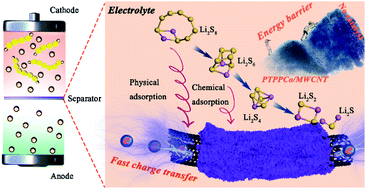Cobalt-doped porphyrin-based porous organic polymer-modified separator for high-performance lithium–sulfur batteries†
Abstract
Lithium–sulfur (Li–S) batteries are the most promising next-generation energy storage devices owing to their excellent theoretical specific capacity (1675 mA h g−1) and the abundant availability of sulfur resources at low costs. However, serious shuttle effects and sluggish reaction kinetics obstruct the practical implementation of Li–S batteries. Herein, a functional separator modified with polytetraphenylporphyrin cobalt adsorbed onto multi-walled carbon nanotubes (PTPPCo/MWCNT) was fabricated by a simple vacuum filtration method. Because of the excellent conductivity of the MWCNT as well as the enhanced chemical adsorption and powerful catalytic activity of PTPPCo, the shuttle effect was effectively suppressed and the reaction kinetics were greatly enhanced. Consequently, the Li–S cells with the modified functional separator PTPPCo/MWCNT showed a prominent initial reversible capacity of 1330 mA h g−1 at a current density of 0.2C, enhanced rate performance, outstanding cycling stability (with a slight average capacity decay of 0.038% per cycle at 2C for 500 cycles), and excellent anti-self-discharge ability.



 Please wait while we load your content...
Please wait while we load your content...